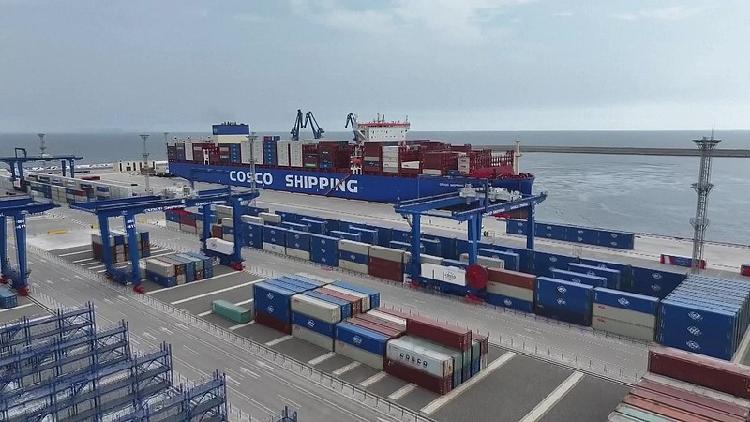Trade between China and Latin America Flourishes, with Brighter Prospects Ahead
China's trade with Latin America is experiencing significant growth, presenting even greater opportunities for the future.

In recent years, Chinese President Xi Jinping has laid out a new vision for constructing a China-Latin America and the Caribbean community with a shared future, steering the China-LAC relationship into a new phase characterized by equality, mutual benefit, innovation, openness, and benefits that prioritize people. With head-of-state diplomacy guiding the way, trade and economic cooperation between China and LAC has overcome numerous obstacles, yielding impressive outcomes. China has become the region's second-largest trading partner, with bilateral trade experiencing rapid growth for seven consecutive years. Additionally, China's "circle of friends" in LAC continues to grow.
This year marks the 20th anniversary of the first free trade agreement signed between China and LAC nations. Over the past two decades, the development of free trade agreements between the two has broadened their scope, improved quality, and increased the efficiency of China's network of high-standard free trade areas. Since 2005, China has entered into five free trade agreements in LAC with Chile, Peru, Costa Rica, Ecuador, and Nicaragua. Notably, the agreements with Ecuador and Nicaragua were finalized during the 14th Five-Year Plan period. China is also accelerating negotiations for a free trade agreement with Honduras, having reached an early harvest arrangement, and discussions with El Salvador are moving forward as efforts are made to finalize agreements with additional LAC countries.
The free trade agreements between China and LAC countries embody the standards typical of advanced free trade agreements. The agreements signed with Chile and Peru have both seen upgrades in recent years. The China-Nicaragua free trade agreement, signed in August 2023, represents China's inaugural effort to facilitate cross-border trade in services and investment using a negative list approach.
In 2024, while serving as the rotating chair of the Regional Comprehensive Economic Partnership, China collaborated with other RCEP members to streamline the processes for new member nations. During this time, Chile officially expressed its intent to join the RCEP, heralding a promising future for more advanced China-LAC free trade collaboration on wider platforms.
Over the last 20 years, the free trade agreements between China and LAC countries have resulted in significant achievements, fostering trade growth while benefiting businesses and individuals in both China and the LAC region.
Following the implementation of the China-Chile free trade agreement in 2006, bilateral trade has surged, reaching $61.66 billion in 2024—8.6 times more than in 2006. This expansion notably outstripped the 3.2-fold increase in China's overall foreign trade during the same period. In the ten years after the agreement took effect, China progressively eliminated tariffs on Chilean wine, resulting in a 13-fold increase in imports of this product. This not only catered to the diverse tastes of Chinese consumers but also opened up numerous opportunities for Chilean businesses. Similarly, Chilean cherries have benefitted from free trade, becoming a favored fruit among buyers in China.
The China-Peru free trade agreement, enforced in 2010, has simultaneously spurred and benefited from rapid bilateral trade growth. In 2024, trade between the two countries reached $43.36 billion, seven times higher than the figure recorded in 2010—significantly eclipsing the 1.7-fold increase in China's overall foreign trade during that timeframe. Peruvian exports like blueberries, grapes, avocados, and squid have successfully penetrated the Chinese market, while Chinese products, including smartphones, toys, and passenger vehicles, have gained considerable popularity in Peru.
Officially in effect since 2011, the China-Costa Rica free trade agreement saw trade between the two nations reach $7.76 billion in 2024, marking a 36.1% year-on-year increase. During this period, China's imports from Costa Rica climbed by 50.1%, while exports to Costa Rica grew by 21.4%. These growth figures surpassed the overall expansion of China's foreign trade, underscoring the positive outlook for enhanced bilateral trade and economic cooperation.
The three agreements that went into effect in 2024 have also demonstrated notable results. The China-Nicaragua free trade agreement took effect on January 1, 2024, with bilateral trade increasing by 46.8% year on year. Specifically, China's exports to Nicaragua rose by 40.8% year on year, while imports surged by 218.3%. Nicaraguan exports of products such as sugar, frozen lobster, white shrimp, and cotton yarn have rapidly entered the Chinese market, starting from virtually zero. Meanwhile, competitively priced Chinese products like passenger vehicles, motorcycles, phones, knitwear, and rubber goods have greatly enhanced the livelihoods of local communities.
The China-Ecuador free trade agreement launched on May 1, 2024. In its initial month, China's imports from Ecuador reflected growth both year-over-year and month-over-month. From May to December 2024, China's total imports from Ecuador reached $5.78 billion, showing a 10.1% increase compared to the same period in 2023. Ecuador's flagship exports—frozen squid, frozen lobster, frozen fish, coffee, cocoa beans, pitaya, and fishmeal—achieved substantial growth in export levels to China. Concurrently, Chinese products such as smartphones, motorcycles, refrigerators, and generators have become accessible in many Ecuadorian households, enhancing the day-to-day lives of local residents.
Less than six months after the early harvest arrangement of the China-Honduras free trade agreement, Honduran white shrimp has successfully entered the Chinese market. At the same time, Hondurans can now enjoy tilapia imported from China at more accessible prices, directly benefiting from the bilateral free trade cooperation.
Sharing a common future, both sides need to collaborate effectively moving forward. The resolution adopted at the Third Plenary Session of the Communist Party of China's 20th Central Committee in July 2024 emphasized that openness is a defining characteristic of Chinese modernization, urging a commitment to the fundamental state policy of openness to the outside world, alongside a continued push for reform through this openness.
China's increasingly open market is poised to provide greater opportunities for LAC countries. At this new historical starting point, China and LAC nations should leverage their respective advantages and deepen free trade cooperation to maximize the benefits of these agreements for their citizens. Both parties should aim for tangible progress in establishing a China-LAC community with a shared future, steering the partnership toward an even more promising horizon.
Jessica Kline for TROIB News
Find more stories on Business, Economy and Finance in TROIB business












